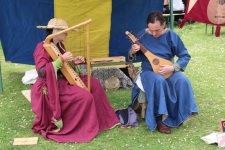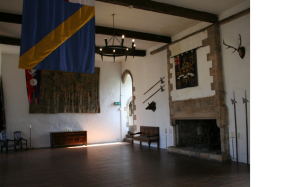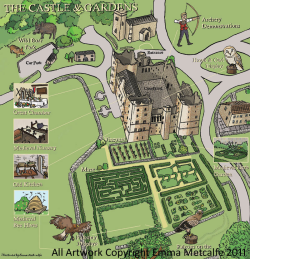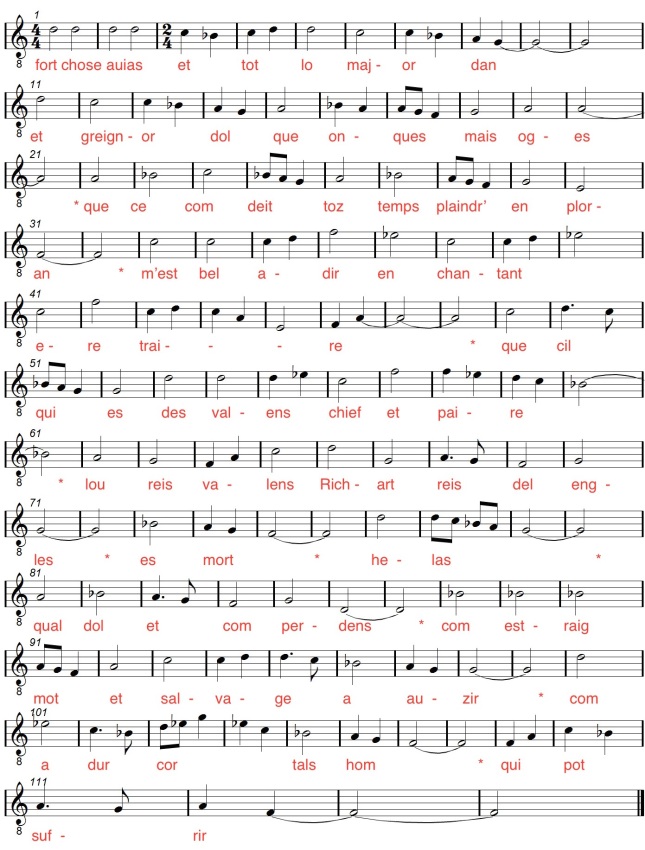This is an online version of our latest Medieval Music in the Dales newsletter – though don’t forget if you want to get the newsletter as an email, just get in touch. We’ve been really busy with fundraising over the last couple of months, and here’s what we’ve been up to…
I’ve made three applications for funding so far. The major one is the Grants for the Arts application to Arts Council England – this is for about 55% of the total funding, so is obviously fairly significant! It was clear to us that MMITD is a pretty unique event that will involve a huge number of musicians and crafts people, and it seemed perfect… With all the pressure on the public purse at the moment, nothing can be taken for granted, but we will know by the end of January if our bid will be successful. Please keep your fingers crossed – it was a major undertaking just completeing the paperwork!!!
 I also considered special interest groups that might like to back MMITD. I was really delighted to hear that The Bagpipe Society were offering grants. They were really happy to support MMITD, specifically and for the most part to fund the travel expenses to the UK of Danilo Turchetti of Musica Inspirata, who is busily reinventing the medieval bagpipe to exquisite effect.
I also considered special interest groups that might like to back MMITD. I was really delighted to hear that The Bagpipe Society were offering grants. They were really happy to support MMITD, specifically and for the most part to fund the travel expenses to the UK of Danilo Turchetti of Musica Inspirata, who is busily reinventing the medieval bagpipe to exquisite effect.
I’ve also looked at local funding sources, and recieved good advice from the Dales Tourism Business Network. And I’m delighted to announce that the Yorkshire Dales National Park Authority Sustainable Development Fund has granted us £700 to support the marketing of the event. Open to any individual, business, community group orvoluntary sector body, the Yorkshire Dales National Park Authority Sustainable Development Fund provides a simple and accessible source of money for a range of projects that result in positive benefits fro the National Park, its env ironment, its economy and its communities, while enhancing and conserving local culture, wildlife and landscape. It’s wonderful that they have decided to assist MMITD in this way.
ironment, its economy and its communities, while enhancing and conserving local culture, wildlife and landscape. It’s wonderful that they have decided to assist MMITD in this way.
More information about the Fund here: http://www.yorkshiredales.org.uk/living-and-working/sdf
How You Can Help One – Crowdfunding in February
Our crowdfunding campaign will be our other major means of fundraising for MMITD. Crowdfunding is a great way of cooperating to make something happen and another great boon of the internet age. Sites like Kickstarter or Crowdfunder allow causes and projects to promote themselves to anyone interested, in the hope of gaining financial support. Supporters can contribute to the project financially by making pledges, and in return they get rewards.
From the start, we thought this would be a great model for MMITD as a way for supporters to book advance tickets – at the most excellent prices, naturally – and other benefits. Thus people who can’t actually come along to MMITD might be interested in the CD or DVD of the event or one of the other commemorative items. Crowdfunding also opens up the option for supporters to sponsor aspects of the event, and indeed to make contributions just because they (rightly!) love the whole idea!
Crowdfunding campaigns typically set a target that they have to reach. on this model, if the target is not reached, the campaign fails and all support is cancelled. So we really want to encourage everyone to get on board and book their tickets good and early so that the campaign will succeed and we can go forward with the clearest idea of our total funding.
Our crowdfunding campaign will begin in mid-Feburary and run through to Easter- and make no mistake, you won’t be able to miss it! Here are the key facts :
- The campaign will run for six weeks, from mid-February to Easter 2016
- There will be a range of tickets available as supporter Rewards.
- One of the Rewards will be the Performer Pass – the cheapest ticket of all and only available as a crowdfunding Reward. This is for those who want to take part in the Open Stages and be part of the music-making.
- Crowdfunding tickets will be cheaper than those available later!
- Crowdfunding tickets will be the only way to reserve the limited camping pitches
- Crowdfunding ticket-buyers get priority on their choice of workshops and concerts
- You can make more than one pledge!
- If you are feeling especially generous, crowdfunding offers the opportunity to sponsor a concert or a workshop – all such offers are gratefully received…
- When you make your Pledge to buy a ticket, I will be in touch with a booking form. As appropriate, you can specify all your choices for workshops on this and – if applying for a Performer Pass – also give details of your performance, instruments, repertoire etc.
- And – most important – we’ve got to reach the target by Easter!!!
Full advance details of the full range of pledges and rewards will be released in the first half of February. Please help us all out by joining in the Crowdfunding Campaign.
How You Can Help Two: 
This is a frankly splendid idea. I caught on to it because I saw a Facebook post from the Oxford Folk Weekend announcing that they had raised several hundred pounds for their very splendid event via this ‘easyfundraising.org.uk’. I looked it up and saw it could be a great way to raise money for MMITD. Here’s how it works.
Whenever you buy anything online – from your weekly shop to your annual holiday to your car insurance – you could be raising a free donation for Medieval Music in the Dales There are nearly 3,000 retailers on board ready to make a donation, including Amazon, John Lewis, Aviva, thetrainline and Sainsbury’s – and it doesn’t cost you a penny extra!
It’s really simple, all you have to do is:
-
Join – Head to easyfundraising.org,uk and sign up for free as a supporter.
-
Shop – Every time you shop online, go to easyfundraising first, pick the retailer you want and start shopping.
-
Raise – After you’ve checked out, that retailer will make a donation to your good cause for no extra cost whatsoever.
There are no catches or hidden charges at all – it’s a win-win all round. For example, I most recently bought a few Christmas presents at John Lewis and got a £1.35 donation! A £40 train ticket booked through thetrainline earnt £0.64. Even a film rented on Amazon bought a few pennies.. I’m sure you can see how it can all add up – but we really need a few more of you good people to sign up as supporters. Give it some thought?
Once you’re signed up, you can also install an easyfundraising Donation Reminder on your computer, which will give you a handy little reminder whenever a donation is available when you’re shopping online – so you never miss the chance to donate. When you see the alert, just click to activate your donation. It’s as easy as that! Shoppers who use the easyfundraising Donation Reminder raise five times more donations for their cause because it helps them remember. You’ll love it and we will too! Find out more and help raise five times more for Medieval Music in the Dales here.
Also, if you shop on your mobile or tablet, you could get the free easyfundraising app and again you’ll never miss a donation. To get it, visit the App Store or Google Play and search for ‘easyfundraising’ or find out more here.
Other new developments since September
There have also been exciting developments on the line-up front since September. Our line-up for the luthiers’ exhibition is now as follows:
- Ardival Harps (wire and git-strung historical harps)
- Atelier Elbock (flutes of many kinds)
- AtelierTri Nox Samoni (flutes of many kinds, lyres, early guitars)
- Early Music Shop (wide range of historical and folk instruments)
- George Stephens (medieval gitterns, lutes, harps)
- Kalum Hewitt (medieval soundbox instruments of many kinds)
- Jim Parr (bagpipes and shawms)
- Leaf Trading Post (bone flutes, percussion)
- Margotton Lutherie (soundbox instruments of many kinds)
- Musica Inspirata (bagpipes)
- Phil Bleazey (flutes of many kinds)
- Philippe Bolton (recorders)
And there are a couple more very likely but still to be confirmed (we like to keep you guessing a bit…) Full details will be confirmed in the next newsletter – out in early February.
Finally – more on the location for MMITD: The Yorkshire Dales

There’s no getting away from it, the Yorkshire Dales are one of the most splendid areas of outstanding natural beauty in the country. Being able to have our event in such a stunning location is a definite plus.
The Yorkshire Dales is the second largest national park in England after the Lake District. One of its most distinctive features is its network of drystone walls, and there are 8689km of them! They are formed from the limestone that is the bedrock of the Dales and which contributes so much to its unique character.
walls, and there are 8689km of them! They are formed from the limestone that is the bedrock of the Dales and which contributes so much to its unique character.
The Yorkshire Dales have been shaped by thousands of years of human occupation, with each dale having its own special character. One of the most fascinating finds in the area is the Iron Age bone flute found near Malham – so MMITD is part of a very long musical heritage indeed!
Pictures courtesy of The Yorkshire Dales National Park Authority.
For all general enquiries or to join the mailing list please email: medievalmusicinthedales@gmail.com
There’s also our spanking new website: http://www.medievalmusicinthedales.co.uk
You can like the Medieval Music in the Dales Facebook Page: http://www.facebook.com/medievalmusicinthedales
You can also contact Trouvère
by email: trouvere_york@hotmail.com
by phone: 07720118406
and our website is: http://www.medievalminstrels.com













